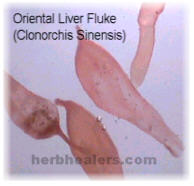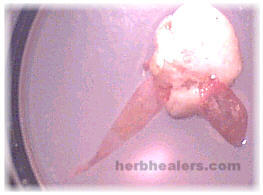 Parasite Primer: Some of the
Parasite Primer: Some of the
Pests This Product Expels

 TREMATODES - Shown
here: Cionorchis sinensis - 60X.
Human flukes include the
Oriental Liver Fluke (Cionorchis sinensis), the Sheep Liver
Fluke (Fasciola hepatica), and the common Intestinal Fluke
(Fasciolopsis buski) - all belonging to the class "Trematoda"
and usually referred to as trematodes, or just
flukes.
The internet is
rich with pictures of trematodes (see also Ohio State's
alphabetical
listing of graphic parasite images.) Nevertheless, the
pictures on this page are unique:
they were all taken from stool samples from people who used
Old Amish Dewormer - and unlike nearly all pictures you
will find elsewhere on the net, where dead specimens are photographed
using slide stains under a microscope, most of these specimens
were still alive when photographed.
TREMATODES - Shown
here: Cionorchis sinensis - 60X.
Human flukes include the
Oriental Liver Fluke (Cionorchis sinensis), the Sheep Liver
Fluke (Fasciola hepatica), and the common Intestinal Fluke
(Fasciolopsis buski) - all belonging to the class "Trematoda"
and usually referred to as trematodes, or just
flukes.
The internet is
rich with pictures of trematodes (see also Ohio State's
alphabetical
listing of graphic parasite images.) Nevertheless, the
pictures on this page are unique:
they were all taken from stool samples from people who used
Old Amish Dewormer - and unlike nearly all pictures you
will find elsewhere on the net, where dead specimens are photographed
using slide stains under a microscope, most of these specimens
were still alive when photographed.
 Flukes look very different when
alive then when they do after they are dead, flattened, aged, stained,
and shot under a microscope. No wonder most doctors can't identify
them - and when they do it is usually because symptoms are so
acute that the doctor orders an pathology examination of the
stool, wherein eggs are found. (When it gets to that point, how
could you possibly miss them? Each adult can put out 50-100,000
eggs per day, so a stool sample from an acute case will have eggs
numbering in the many millions.) Identifying marks include a wide body
that tapers at one end like a balloon and at the other end like
a nipple, where the mouth attaches and feeds from the host.
This "mouth" serves the same purpose as the "probiscus" feeding
tube on a mosquito. Flukes tend to pink or reddish in color,
since YOUR blood is providing the color. Like all parasites,
flukes do their damage by drawing their food and nutrients from
YOUR body - the very same place they deposit their waste! Flukes look very different when
alive then when they do after they are dead, flattened, aged, stained,
and shot under a microscope. No wonder most doctors can't identify
them - and when they do it is usually because symptoms are so
acute that the doctor orders an pathology examination of the
stool, wherein eggs are found. (When it gets to that point, how
could you possibly miss them? Each adult can put out 50-100,000
eggs per day, so a stool sample from an acute case will have eggs
numbering in the many millions.) Identifying marks include a wide body
that tapers at one end like a balloon and at the other end like
a nipple, where the mouth attaches and feeds from the host.
This "mouth" serves the same purpose as the "probiscus" feeding
tube on a mosquito. Flukes tend to pink or reddish in color,
since YOUR blood is providing the color. Like all parasites,
flukes do their damage by drawing their food and nutrients from
YOUR body - the very same place they deposit their waste!
 Americans have an expression,
which, stated in vernacular, says, "You don't sh** where you eat!"
Unfortunately, these parasites add insult to injury by doing
precisely that - and if the reference appears unseemly, it is
only to provide graphic clarity as to the damage these organisms
can bring. This point needs accentuation in particular because
of the subclinical states they induce. The orthodox community
goes to considerable length to stress that
parasites
do not cause serious illness. We would agree with them that there
is no proof that they serve as sole etiological agents, but how in
the world can they NOT be contributing factors? It is our
opinion that parasites are today where diet and nutrition
was 45 to 50 years ago. Americans have an expression,
which, stated in vernacular, says, "You don't sh** where you eat!"
Unfortunately, these parasites add insult to injury by doing
precisely that - and if the reference appears unseemly, it is
only to provide graphic clarity as to the damage these organisms
can bring. This point needs accentuation in particular because
of the subclinical states they induce. The orthodox community
goes to considerable length to stress that
parasites
do not cause serious illness. We would agree with them that there
is no proof that they serve as sole etiological agents, but how in
the world can they NOT be contributing factors? It is our
opinion that parasites are today where diet and nutrition
was 45 to 50 years ago.
 Conventional medicine had
to be dragged --- kicking and screaming the whole way, that diet and
nutrition played a role in overall health. (Always last to
acknowledge the obvious, that monolithic writ of orthodoxy,
the Journal of the American Medical Association (JAMA)
took cigarette advertisements showing the healthfulness
of tobacco smoking as late as the 1950's, as John McDougall, M.D.,
pointed out in The McDougall Plan.) Conventional medicine had
to be dragged --- kicking and screaming the whole way, that diet and
nutrition played a role in overall health. (Always last to
acknowledge the obvious, that monolithic writ of orthodoxy,
the Journal of the American Medical Association (JAMA)
took cigarette advertisements showing the healthfulness
of tobacco smoking as late as the 1950's, as John McDougall, M.D.,
pointed out in The McDougall Plan.)
 Fifty years from now,
the truth about the role of parasites will have gone through
the same metamorphosis. Fifty years from now,
the truth about the role of parasites will have gone through
the same metamorphosis.

 Truth is, flukes are incredibly
common. Orthodoxy also treats them as someone else's problem -
acknowledging that
an estimated 30,000,000 people in Asia have them, but implying it is
uncommon in the West. Tell that to the people in Ohio who sent
us this picture. According to colon hydrotherapists we have
spoken to, the adults often show up in the "viewing tube" -
visible because at 10-25 mm you can see them if you look close.
In most of these instances, the adults are dead when expelled.
When using our Dewormer you can often see them coming
out still alive and motile. Truth is, flukes are incredibly
common. Orthodoxy also treats them as someone else's problem -
acknowledging that
an estimated 30,000,000 people in Asia have them, but implying it is
uncommon in the West. Tell that to the people in Ohio who sent
us this picture. According to colon hydrotherapists we have
spoken to, the adults often show up in the "viewing tube" -
visible because at 10-25 mm you can see them if you look close.
In most of these instances, the adults are dead when expelled.
When using our Dewormer you can often see them coming
out still alive and motile.
 In the second fluke picture
(above, right), you can see (at 60x) adult flukes that have been
expelled in a white liver stone. Liver stones come in all
colors, by the way, from a bright, healthy green, to white,
to various shades of brown, even black. The very small
dark brown and black stones tend to be quite malodorous.
These stones are mostly minerals (i.e. calcium, magnesium,
etc.) and cholesterol - and will float in water. Those
that are browner or "meatier" looking usually smell quite
bad and indicate that the liver needs attention. Some
that are high in heavy metals can actually look like
pretty rocks. In the second fluke picture
(above, right), you can see (at 60x) adult flukes that have been
expelled in a white liver stone. Liver stones come in all
colors, by the way, from a bright, healthy green, to white,
to various shades of brown, even black. The very small
dark brown and black stones tend to be quite malodorous.
These stones are mostly minerals (i.e. calcium, magnesium,
etc.) and cholesterol - and will float in water. Those
that are browner or "meatier" looking usually smell quite
bad and indicate that the liver needs attention. Some
that are high in heavy metals can actually look like
pretty rocks.
 People with no gallbladder
tend to have more parasites. When the bile reserve and valve
are cut away, the end result is a dry liver with weak bile. People with no gallbladder
tend to have more parasites. When the bile reserve and valve
are cut away, the end result is a dry liver with weak bile.
|
Stones & Flukes
 Above: For reasons that are not entirely
clear to us, stones appear to be the constant and abiding companions
of those who have flukes. The vast majority of stones are expelled
as very small objects - difficult to notice, let alone identify -
but among those who suffer from advanced degenerative diseases,
the results from the stool samples are too big not to notice
after a thorough parasite cleanse. In the photograph above
(click to enlarge),
taken from a woman in her 90's, a collection of gallbladder and
liver stones is found - and almost to a stone, there are flukes
in and around the stones. Above: For reasons that are not entirely
clear to us, stones appear to be the constant and abiding companions
of those who have flukes. The vast majority of stones are expelled
as very small objects - difficult to notice, let alone identify -
but among those who suffer from advanced degenerative diseases,
the results from the stool samples are too big not to notice
after a thorough parasite cleanse. In the photograph above
(click to enlarge),
taken from a woman in her 90's, a collection of gallbladder and
liver stones is found - and almost to a stone, there are flukes
in and around the stones.
Never Too Young
(Unfortunately)
 Above: Parasites are not solely
the domain of the aged and infirm. The photo above (taken at 60x)
was taken from a 15 year old girl after her first parasite cleanse.
The herbalist examining the sample noticed what almost looked
like a mosquito: a body with a set of what looked like "wings."
He could not identify the object as it did not fit the
morphology of any parasite, regardless of developmental
stage, he had seen. So he gently pushed the object around
in the petri dish - and out spewed a sack full of parasite eggs.
(Note: the most telltale sign of an adult parasite is the
presence of a sack containing identifiable eggs.) Above: Parasites are not solely
the domain of the aged and infirm. The photo above (taken at 60x)
was taken from a 15 year old girl after her first parasite cleanse.
The herbalist examining the sample noticed what almost looked
like a mosquito: a body with a set of what looked like "wings."
He could not identify the object as it did not fit the
morphology of any parasite, regardless of developmental
stage, he had seen. So he gently pushed the object around
in the petri dish - and out spewed a sack full of parasite eggs.
(Note: the most telltale sign of an adult parasite is the
presence of a sack containing identifiable eggs.)
 The picture below shows
the eggs at 200x. Upon close examination, the herbalist found
that the eggs were actually "pulsating" as if the parasites had
a circulatory system (which they do not).
Click on either picture (above or below)
to see enlargement. The picture below shows
the eggs at 200x. Upon close examination, the herbalist found
that the eggs were actually "pulsating" as if the parasites had
a circulatory system (which they do not).
Click on either picture (above or below)
to see enlargement.
|





